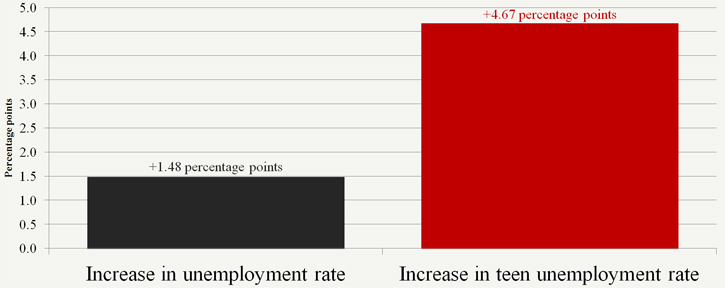Minimum Wage Increase Is Bad for Jobs
President Obama has expressed support for an increase in the federal minimum wage from $7.25 to $10.10 an hour: a 39 percent increase. Senator Harkin and 37 Democrat cosponsors have introduced S. 1737. That bill would raise the federal minimum wage to $10.10 an hour over two and a half years and index it to inflation after that. Democrats are set on this course even though it will destroy jobs for some low-wage workers and harm job creation.
CBO Predicts Job Loss from Minimum Wage Increase
The nonpartisan Congressional Budget Office expects the Democrats’ minimum wage plan would reduce total employment by about 500,000 workers -- and by as many as one million.

Source: CBO
CBO says that increased earnings would not “only go to low-income families, because many low-wage workers are not members of low-income families.” In fact, just 19 percent would go to families with earnings below the poverty level, while 29 percent would go to families earning more than three times that threshold. The increased earnings for some workers would be offset by reduced income for those who become jobless as a result of the higher minimum wage. Business owners, consumers, and taxpayers would face higher prices.
CBO notes that the reduction in employment of low-wage workers is generally greater in the long term, as employers replace low-wage workers with more productive, higher-wage workers or equipment. Some employers seeking to offset higher wages for minimum-wage workers will also reduce training. This is particularly harmful for low-wage, entry-level workers who learn
important jobs skills in these positions. According to a 2004 study, the vast majority of minimum wage workers earn a pay increase within 12 months on the job. Raising the minimum wage could remove this important first step on the ladder for some people.
In February, President Obama unilaterally raised the minimum wage to $10.10 an hour starting January 1, 2015, for workers on federal contracts. His executive order also extended this minimum wage to tipped employees and workers with disabilities.
Minimum Wage Hike Harms Job Growth and Existing Employment
Democrats assert that raising the minimum wage will help low-wage workers. On the contrary, a study last year found that an increase in the minimum wage could actually hinder the hiring of low-wage workers. Economists at Texas A&M University estimated the loss in job growth in each state under a minimum wage of $10 an hour. The researchers found that more than 2.3 million new jobs would be lost nationwide. A state-by-state breakdown showed job losses ranging from 5,100 in Alaska to 219,400 in Texas.
Not only would an increase in the minimum wage reduce new hiring at a time when the country desperately needs jobs, it would actually tip the balance in many states from net employment gains to net losses. In all, 32 states that are currently experiencing employment growth would face a decrease in employment if the minimum wage were increased to $10 an hour.
Who Gets Hurt the Most by Increasing the Minimum Wage?
New data from the Labor Department show that 58.8 percent of all workers in 2013 were hourly workers, but only 4.3 percent of them are at or below the federal minimum wage. That’s down from 4.7 percent in 2012 and 13.4 percent in 1979.
About half of all minimum wage workers are less than 25 years old. Among employed teenagers (ages 16 to 19) paid by the hour, about 20 percent earned the minimum wage or less, compared with three percent of workers age 25 and over. Additionally, only two percent of full-time workers were paid the minimum wage.
The most recent unemployment rate for teenagers was 21.4 percent. An increase in the federal minimum wage would be particularly harmful to this group struggling to get on the employment ladder. When employer costs are arbitrarily increased, such as with an increase in the minimum wage, they become more likely to hire experienced workers and less likely to take a chance on young workers.
In 2013, 19 states had minimum wages above the federal level of $7.25 per hour. An analysis of employment in these states found a one dollar increase in the minimum wage would result in a 1.48 percentage point increase in the unemployment rate. But a one dollar increase correlated to a 4.67 percentage point increase in teenage unemployment rate.
Teens bear the brunt
Increase in unemployment rate from a $1 hike in minimum wage

Source: AAF
A one-size-fits-all minimum wage also ignores the significant differences in the cost of living across the country. In Pueblo, Colo., the cost of living is 17 percent lower than the national average. Yet an increase in the federal minimum wage would raise it to the same level in Pueblo as in New York City. According to the American Enterprise Institute, thousands of smaller, rural communities across the country where the cost of living is lower would see the greatest adverse effect on job opportunities.
Employers in Pueblo are less able to raise prices to pay for a 40 percent increase in the minimum wage to $10.10 an hour since their customers are less able to pay the higher prices caused by such an increase. As a result, employers in Pueblo and other small communities will be left with the option of eliminating positions, cutting hours, substituting machines and technology for workers, or reducing job growth. Low-skilled workers in lower cost communities would be especially vulnerable to an increase in the federal minimum wage.
President Obama and Democrats in Washington are eager to change the subject from their failed health care law. They want to talk about pocketbook issues they think will help them in the November election. But the minimum wage has the potential to cause unintended consequences that do greater harm to the people they claim to want to help.
Next Article Previous Article
